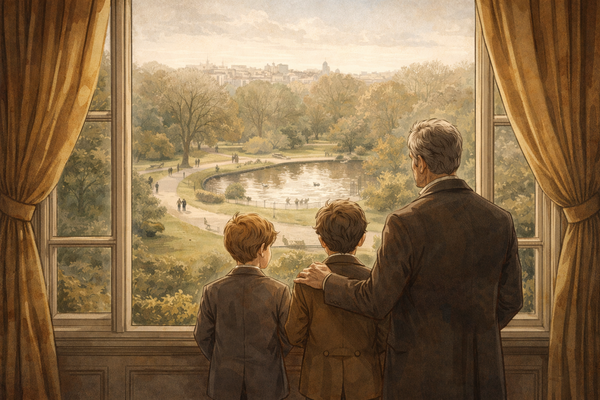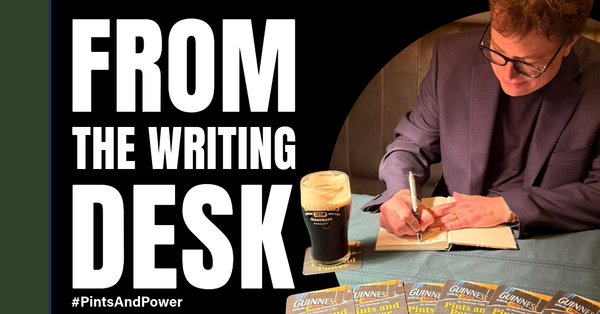Michael Collins, a Pint, and the Power of the Pub
Marking 103 years since Béal na Bláth—how Guinness and the pub framed a revolution.

Friday, August 22, 2025 marked 103 years since Michael Collins was killed at Béal na Bláth in West Cork. The date is fixed in Irish memory—August 22, 1922—a day that ended a life and altered a country. (theirishstory.com)
In Pints & Power, we trace how, in the years before that ambush, the pub wasn’t just a backdrop to the War of Independence—it was part of the toolkit. A pint could lower suspicion. A quiet snug could host an urgent briefing. And Guinness, steady and ordinary, kept flowing through extraordinary times. That’s the context—and the contradiction—Collins understood: a public house that made private work possible.
There are stories—some apocryphal, some true—of Collins slipping into a bar, nodding to the barman, and blending seamlessly into the hum of a Dublin night. The pint beside him was both cover and comfort. In those dangerous years, it became part of the ordinary, extraordinary rhythm of rebellion.
-- excerpt from Chapter 3 Brewing Through Revolution, Pints and Power
The War of Independence, 1919–1921
The Easter Rising lit a fuse. Within three years, Ireland launched a full-scale guerrilla war against British rule. Michael Collins and the Irish Republican Army (IRA)...
Paid Subscribers can read the entire section from the book in the Members Only Area
Devlin’s: an upstairs headquarters with a new plaque
On Parnell Street, the former Devlin’s Pub has been marked with a Dublin City Council commemorative plaque noting its role as a meeting place for GHQ Intelligence from 1919 to 1921. According to coverage by The Irish Post, Liam Devlin offered rooms to Collins soon after taking over the premises; it became a daily rendezvous for Volunteers and Intelligence officers. (The Irish Post)

Dublin City Council’s announcement underscores the site’s significance as a wartime hub for Collins’ intelligence network.
Meetings were held daily at the pub, attended by Michael Collins, Frank Thornton, Liam Tobin, Emmet Dalton and many others of the leadership of the Volunteers and the IRB… As many as eight to ten volunteers and officers were accommodated there every night during this period.
-- Dublin City Council
If you’re walking the area, you’ll find the marker at the old Devlin’s site near the corner of Parnell Street and Moore Lane. (HMDB)
Why the pub mattered
Collins grasped the social camouflage of a full glass. In a crowded bar, a rebel with a pint looked like everyone else; a tab extended by a sympathetic publican doubled as a vote of confidence. This wasn’t romance—it was method. In some districts, even as the brewery worked within British trade networks to stay alive, local IRA figures shielded Guinness deliveries because wages and livelihoods depended on them. The pint, at times, functioned as a fragile truce that crossed lines and lowered voices.
On screen: how Michael Collins (1996) uses pubs as stages
Neil Jordan’s film leans into this truth: pubs are where risk and routine meet. A brief scene was shot in J&M Cleary’s on Amiens Street—one of Collins’ historic haunts—which gives the movie an authentic, lived‑in texture. (The Dublin Publopedia, Hospitality Ireland)
Another pub interior/exterior used for the production was Tutty’s of Hollywood (County Wicklow), a reminder that the film’s “pub geography” threads together real houses of talk, cover, and conspiracy. (IMDb)
If you’re rewatching this week, keep an eye on the pub scenes: the low light, the hush after the door closes, the way information moves faster than the stout settles. The film is dramatization, yes, but its choice of public houses feels true to Collins’ city. (Wikipedia)
Scene from the 1996 film biography Michael Collins starring Liam Neeson and Stephen Rea
Beyond the pint: places that hold the story
A short walk from Parnell Street brings you to Vaughan’s Hotel at 29 Parnell Square West—once a Collins safe house and an IRA nerve center during the revolutionary period. The building survives, its façade a quiet witness to meetings that changed the map. (Buildings of Ireland)
Remembering, properly
Anniversaries can turn flesh-and-blood lives into bronze. Collins was neither saint nor statue—he was a strategist who exploited ordinary places for extraordinary work. In our chapter “Brewing Through Revolution,” we follow that thread: the way Guinness and the pub shaped the rhythm of resistance—half shelter, half signal, always public, always hiding in plain sight.
Irish Historian Davy Holden posted the short below on the anniversary which includes first person remembrances surrounding Collins's complex legacy.
Raise a glass to the complexity, not just the legend.
Michael Collins Anniversary short video from Davy Holden
If you go
- Devlin’s Pub plaque (former site): Parnell Street at Moore Lane—Dublin City Council commemorative plaque marking GHQ Intelligence meetings, 1919–1921. (HMDB)
- Vaughan’s Hotel (exterior): 29 Parnell Square West—associated with Collins’ operations during the War of Independence. (Buildings of Ireland)
- J&M Cleary’s (Amiens Street): Filming location for a brief Michael Collins scene and a venue linked to Collins’ Dublin routines. (The Dublin Publopedia, Hospitality Ireland)





